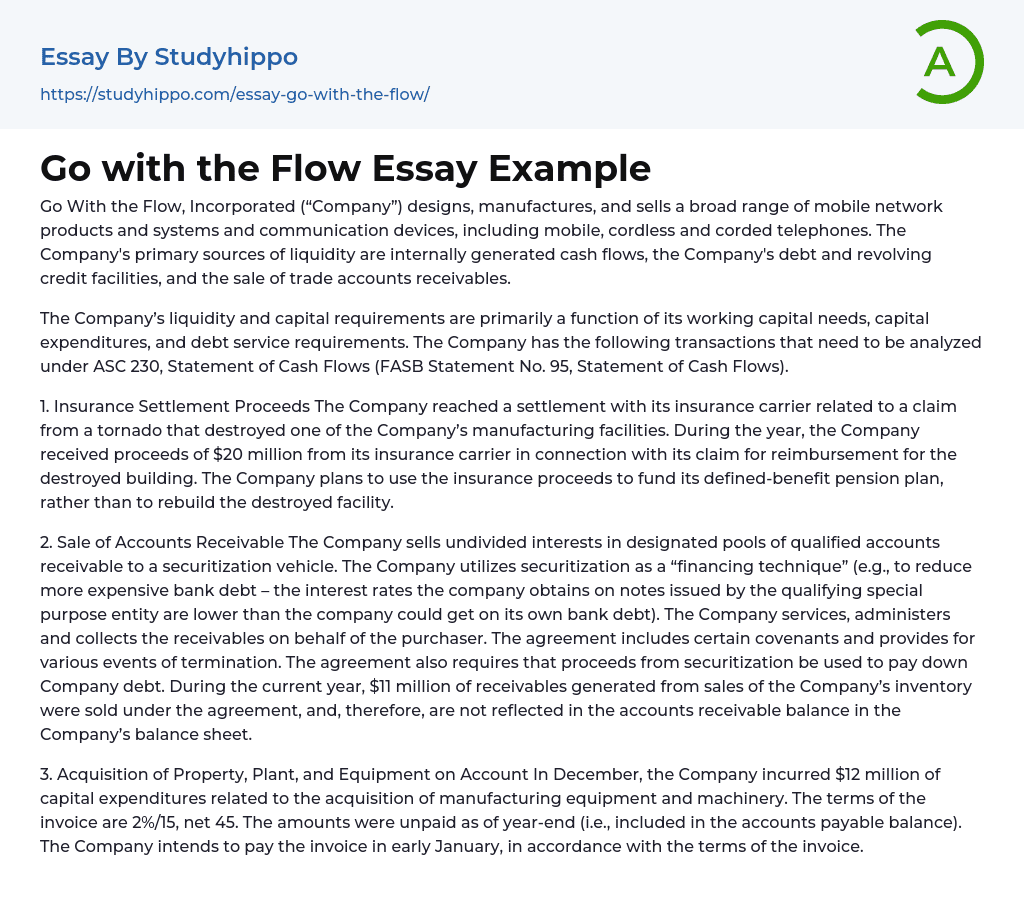Go With the Flow, Incorporated (“Company”) designs, manufactures, and sells a broad range of mobile network products and systems and communication devices, including mobile, cordless and corded telephones. The Company's primary sources of liquidity are internally generated cash flows, the Company's debt and revolving credit facilities, and the sale of trade accounts receivables.
The Company’s liquidity and capital requirements are primarily a function of its working capital needs, capital expenditures, and debt service requirements. The Company has the following transactions that need to be analyzed under ASC 230, Statement of Cash Flows (FASB Statement No. 95, Statement of Cash Flows).
1. Insurance Settlement Proceeds The Company reached a settlement with its insurance carrier related to a claim from a tornado that destroyed one of the Company’s manufacturing facil
...ities. During the year, the Company received proceeds of $20 million from its insurance carrier in connection with its claim for reimbursement for the destroyed building. The Company plans to use the insurance proceeds to fund its defined-benefit pension plan, rather than to rebuild the destroyed facility.
2. Sale of Accounts Receivable The Company sells undivided interests in designated pools of qualified accounts receivable to a securitization vehicle. The Company utilizes securitization as a “financing technique” (e.g., to reduce more expensive bank debt – the interest rates the company obtains on notes issued by the qualifying special purpose entity are lower than the company could get on its own bank debt). The Company services, administers and collects the receivables on behalf of the purchaser. The agreement includes certain covenants and provides for various events of termination. The agreement also requires that proceeds fro
securitization be used to pay down Company debt. During the current year, $11 million of receivables generated from sales of the Company’s inventory were sold under the agreement, and, therefore, are not reflected in the accounts receivable balance in the Company’s balance sheet.
3. Acquisition of Property, Plant, and Equipment on Account In December, the Company incurred $12 million of capital expenditures related to the acquisition of manufacturing equipment and machinery. The terms of the invoice are 2%/15, net 45. The amounts were unpaid as of year-end (i.e., included in the accounts payable balance). The Company intends to pay the invoice in early January, in accordance with the terms of the invoice.
- Accountability essays
- Accounting Software essays
- Accounts Receivable essays
- Auditor's Report essays
- Balance Sheet essays
- Cash essays
- Cash Flow essays
- Costs essays
- Financial Audit essays
- Internal Control essays
- International Financial Reporting Standards essays
- Management Accounting essays
- Principal essays
- Tax essays
- Bank essays
- Banking essays
- Corporate Finance essays
- Credit Card essays
- Currency essays
- Debt essays
- Donation essays
- Enron Scandal essays
- Equity essays
- Financial Accounting essays
- Financial Crisis essays
- Financial News essays
- Financial Ratios essays
- Financial Services essays
- Forecasting essays
- Foreign Exchange Market essays
- Free Market essays
- Gold essays
- Investment essays
- Legacy essays
- Loan essays
- Market Segmentation essays
- Money essays
- Personal finance essays
- Purchasing essays
- Retirement essays
- Shareholder essays
- Stock Market essays
- Supply And Demand essays
- Venture Capital essays
- Aviation essays
- Emergency Management essays
- Health Insurance essays
- Insurance essays
- Life Insurance essays
- Public Transport essays




